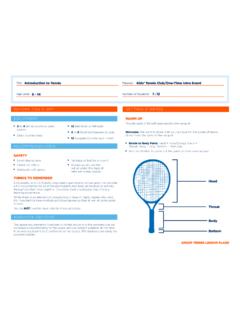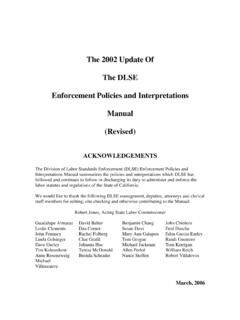Transcription of USTA Officiating: Scenarios and Interpretations
1 1 USTA officiating : Scenarios and Interpretations 2018 Table of Contents The Court .. 1 The Ball .. 1 The Racquet .. 1 Scoring Disputes .. 2 Tiebreaks .. 3 Choice of Ends & Service .. 3 Ball in Play .. 3 Ball Touches a Permanent Fixture .. 3 Serving .. 4 Foot Fault .. 6 Lets .. 7 Balls on the Court .. 7 Loss of Point .. 7 Good Return .. 8 Losing Attire & Dampening Device .. 8 9 Correcting Mistakes .. 10 Continuous Play .. 12 Medical Timeout .. 13 Blood and Vomit .. 15 Toilet/Change of Attire Breaks .. 15 Rest Periods .. 15 Warm-Up .. 18 Coaching .. 18 No-Ad Scoring .. 18 Match Tiebreaks .. 18 Short Sets .. 19 Role of Court Officials.
2 19 Suspension of Play .. 19 Player Misconduct &Point Penalty System .. 20 Appendix: Guidelines for Assessing Penalties .. 24 Index .. 26 ii A. THE COURT 1. Net Cord Tension. - Adjusting net cord tension is recommended before the day s first match and before each match. The ITF recommends net cord tension be between kN and kN with the tension of all nets at a facility within kN of each other. This is approximately equivalent to a net tension between 400 and 450 pounds with the tension of all nets within 25 pounds of each other. Use a net tension device when available. When a device is not available, loosen the center strap, tighten the net cord until the center of the net is approximately 39 inches (991 mm) above the ground, and tighten the center strap until the center of the net is 36 inches (914mm) above the ground.
3 (Rule 1) 2. Where should singles sticks be placed? The center of the singles sticks should be placed 3 feet outside the outer edge of the singles lines and should be diagonally opposite each other. (Rule 1) 3. What happens if a singles stick falls to the court during a point? The point stops immediately and is replayed. (Rule 1) 4. A regular 78-foot court with permanent blended lines is suitable for sanctioned play in divisions that require a 78-foot court. (Rule 1) B. THE BALL 1. What is the difference between a broken ball and a soft ball? A broken ball has no compression; a soft ball has some compression. Both broken and soft balls should be removed from play. (Rule 3) 2. May a player cause a ball to become wet by using the ball to wipe perspiration from the player s body?
4 No. A player may not take any action that materially changes the condition of the ball; therefore, a player may not use a ball to wipe off perspiration. (Rule3) C. THE RACQUET 1. What happens if it is discovered after play has begun that a player has been using an illegal racket or an illegally strung racket? All points played stand. Continued play must be with a legal racket. A player is subject to code violations for delay under the Point Penalty System. If the discovery occurs after the match is over, the match counts. (Rule 4) 2. What may a player who has broken a string or racket do if the player does not have a replacement racket? 1 Unless prohibited by a published rule adopted by the tournament, the player may play with the broken racket.
5 The player may leave the court to get a replacement racket. The player may ask someone else to get a replacement racket. The player is subject to code violations for delays under the Point Penalty System. Rule 29b permits a player reasonable extra time to leave the court only in those cases where clothing, footwear, or necessary equipment (excluding racket) is broken or needs to be replaced. (Rule 4) D. SCORING DISPUTES 1. The Referee and other officials shall settle scoring disputes in non-officiated matches by using their best judgment. They should first attempt to get the players to reconstruct the score so that they agree on it. Thereafter, the following options are listed in order of preference: Counting all points or games agreed on by the players, with only the disputed points or games being replayed (If the players do not agree or recall the court in which the disputed point started, toss a coin to select the court.)
6 ; Playing from a score mutually agreeable to the players; and Deciding the score by a coin toss. (Code 32) 2. The server states that the score is 40-15; the receiver states that the score is 30-30. The players agree on who won every point except for the second point. What should they do? They should replay the second point from the advantage court. If the server wins the point, the score becomes 40-15; if the receiver wins the point, the score becomes 30-30. The next point is played from the deuce court. (Rule 5) 3. What happens in the same situation as above except that the disputed point is the third point? Everything is done the same except that the disputed point is played from the deuce court. (Rule 5) 4.
7 The players agree that they have played six points in the game but disagree over the score because they do not agree on who won the second point. The receiver acknowledges that the server called the score after each point and that the receiver did not express disagreement with the score until now. What should happen? The score as announced by the server should prevail because the receiver did not object. Note, however, if the receiver denied hearing the score, then the normal 3-step process of Code 32 is used to settle the dispute. (Rule 5) 2 E. TIEBREAKS 1. Do the players change ends after a 7-Point Tiebreak is played to decide a set? Yes. (Rule 10) 2. Service Order The player or team whose turn it was to serve first if a full set were played starts serving a 10-Poit Match Tiebreak that is played in lieu of a deciding final set.
8 Each doubles team decides who serves first for its team. (Regulation ) 3. Receiving Positions A doubles team may change receiving positions at the start of a 10-Point Match Tiebreak. (Regulation ) 4. Change of Ends Players change ends at the start of a10-Point Match Tiebreak only if an odd-game changeover is due. During the 10-Point Match Tiebreak, players change ends after every six points, except when the Coman Tiebreak Procedure is used. (Regulation ) F. CHOICE OF ENDS & SERVICE 1. When should the toss be made? The toss should be made before the warm-up so that the players can warm up on the same end from which they play their first game. (Rule 9) G. BALL IN PLAY 1. Is a point decided when a good shot has clearly passed a player, or when an apparently bad shot passes over the baseline or sideline?
9 No. A ball is in play until it bounces twice or lands outside the court, hits a permanent fixture, or hits a player. A ball that becomes embedded in the net is out of play. (Rule 11) H. BALL TOUCHES A PERMANENT FIXTURE 1. During a rally in a singles match played on a doubles court without singles sticks, a player hits a shot that was going out until it hits the doubles post and ricochets into the proper court. Who wins the point? Every effort should be made to provide singles sticks for a match that is played on a doubles court so that this situation does not occur. If it does occur, the player who hit the shot wins the point because the entire doubles net and doubles posts are respectively the net and the net posts for this match.
10 (Rule 13) 3 I. SERVING 1. May a player serve underhanded? Yes. (Rule 16) 2. Where may the server stand? In singles, the server may stand anywhere behind the baseline between the imaginary extensions of the inside edge of the center mark and the outside edge of the singles sideline. In doubles, the server may stand anywhere behind the baseline between the imaginary extensions of the inside edge of the center mark and the outside edge of the doubles sideline. (Rule 18) 3. What does the rule mean when it says that the server may not change position by walking or running ? One key to understanding this rule is to realize that the server s feet must be at rest immediately before beginning to serve. The delivery of the service then begins with any arm or racket motion and ends when the racket contacts the ball (or misses the ball in attempt to strike it).









